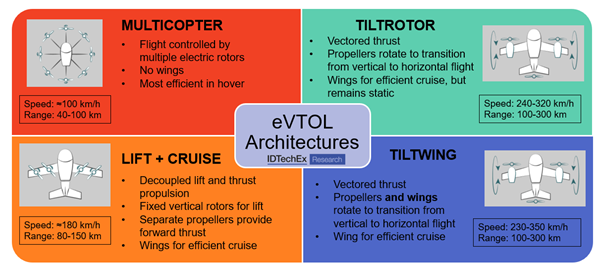Air Taxi Technology

Air taxi technology refers to the use of small, electric or hybrid-electric vertical takeoff and landing (eVTOL) aircraft for transportation of passengers or cargo. These aircraft are designed for short-distance travel, and can take off and land vertically, similar to a helicopter. They are also equipped with advanced navigation and safety systems to enable autonomous flight. Air taxi technology is seen as a potential solution for reducing traffic congestion in urban areas and for providing more efficient transportation options for short-distance travel. However, the technology is still in development and regulatory approval for commercial operation is yet to be granted.

Advantages of air taxi technology include:
- Speed: Air taxis have the potential to reduce travel time for short-distance trips, as they can bypass traffic on the ground.
- Efficiency: Air taxis are electric or hybrid-electric aircraft, which means they have lower environmental impact and operating costs compared to traditional aircraft.
- Convenience: Air taxis can take off and land vertically, which allows them to operate in urban areas and in areas without traditional runway infrastructure.
- Increased accessibility: Air taxis may make air travel more accessible to more people, as they are designed for shorter trips and may be more affordable than traditional air travel.
Disadvantages of air taxi technology include:
- High cost: The development and deployment of air taxi technology is currently expensive, which may make it difficult for companies to operate profitably.
- Safety concerns: Air taxis are still in the early stages of development and there are concerns about the safety of the technology, particularly when it comes to autonomous flight systems.
- Regulatory challenges: The regulatory framework for air taxis is still in development, which may make it difficult for companies to gain approval for commercial operations.
- Noise pollution: air taxis are still not as quiet as people expect, this might be a problem for some cities where noise pollution is strictly regulated.
- Impact on air traffic: The increased number of air taxis in the air may lead to increased air traffic congestion, which would require new regulations and infrastructure to manage.

- Urban air mobility: Air taxis are being developed for transportation of passengers and cargo in urban areas, as a solution for reducing traffic congestion and providing more efficient transportation options.
- Emergency response: Air taxis can be used for emergency medical services, search and rescue operations, and disaster relief.
- Logistics: Air taxis can be used to transport cargo, particularly in urban areas where traditional delivery methods may be hindered by traffic congestion.
- Recreational use: In the future, air taxi technology could also be used for recreational activities such as sightseeing and adventure tourism.
- Military use: Air taxis are being studied for military use as well, for example for reconnaissance, surveillance, and logistics.
Currently, many companies and startups are developing air taxi technology, and some have even started testing their air taxis in real-world environments. However, widespread commercial use of the technology is still some years away, as it is still in the development and testing phase, and regulatory approvals are yet to be granted.

In conclusion, air taxi technology has the potential to revolutionize the way we travel, by providing a faster, more efficient and more convenient mode of transportation for short-distance trips. However, significant challenges still need to be overcome before air taxis can be deployed on a large scale, including the high cost of development and deployment, safety concerns and regulatory challenges. Additionally, air taxis still need to be quiet enough to not cause noise pollution. The technology is currently in development and testing phase, with multiple companies and startups working on it. It is likely that in the next few years, we will see more demonstrations and tests of air taxi technology, but it will take some time before we see widespread commercial use of the technology.
Profit & Solution’s Publication
@debadipb @profitsolutions
#debadipb #profitsolutions #airtaxi #evotl #aviation #plane #drone
